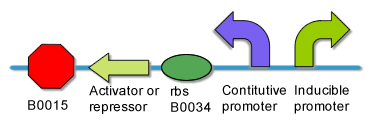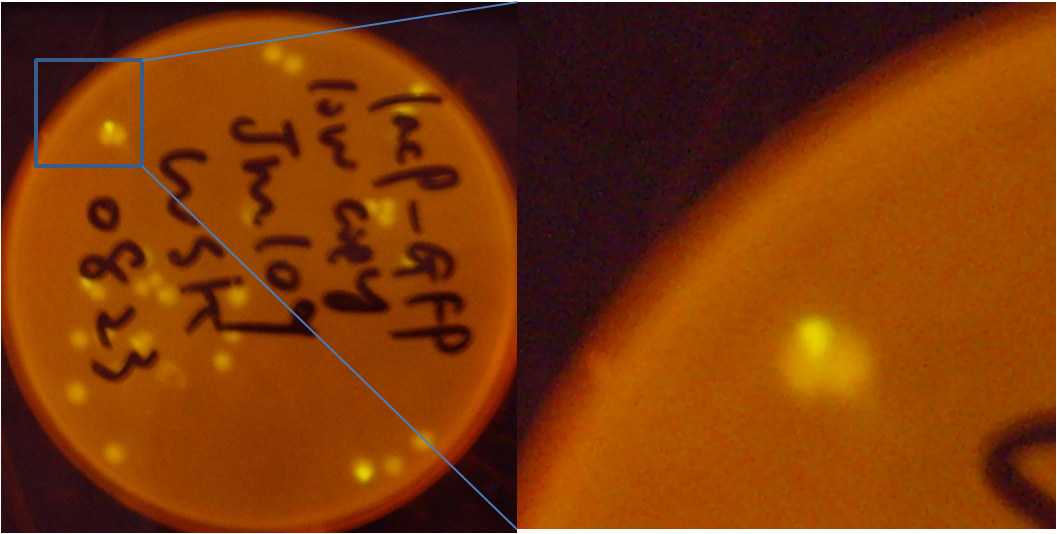Project > AND Gate 1 > Sensor Result
Construction result
Input promoters construction:
In the AND gate, we used five different inducible promoters as inputs: pBad (respond to L-arabinose), pSal (respond to salicylate), pLac (respond to IPTG), pTet (respond to tetracycline), luxP (respond to homoserine lactone). When the inducing small molecule in presence, the promoter is activate, for example, IPTG can activate pLac.
We have constructed four of these inducible systems (including the activator or repressor protein and promoter) and used one directly from other parts. The general pattern is like this:
 fig1. Result of construction They are:
BBa_K228004: NahR-pSal system;
BBa_K228009: AraC-pBad system;
BBa_K228817: lacI-pLac system;
BBa_K228818: tetR-pTet system.
They are not only composite parts which can be used in our project, but also valuable devices employed in other designs or circuits.
For the luxR-luxP system, we simply utilized the parts: BBa_J09855, which is designed and constructed by iGEM2006_Pennstate.
Input promoters test:
In order to characterize the AND gate (e.g. the transfer function), the activities of these promoters should be measured independently by constructing GFP (with strong RBS B0034) downstream the promoters and testing the output in response to the small-molecular inducers.
Therefore we successfully fused these promoters to GFP and test results are following:
aTc Sensor
 Fig1. the result of tet promoter system. This is a picture of tet system, the colonies are green under blue light, even without induction, the upper plate is for comparison.
The tetR-pTet system (parts: , mainly by Shuke Wu)
The colonies which contain the plasmid become very green without induction and showed no induction after aTc is added to the base. The evidence that it is green even without induction is on Fig1a, and the data after induction are not showed here.
Discussion: the leakage is obvious and the reasons may lie in the constitutive promoter we used to drive the expression of tetR and the LVA tag of tetR coding sequence. The constitutive promoter we used is pCat(BBa_I14033) which is a medium promoter, while the natural promoter of tetR is pTet itself. It is likely that the expression of tetR is insufficient to repress pTet. Another possible reason is the LVA tail of the tetR(For detail see BBa_C0040), and its function is for rapid degradation the protein. As a natural result, the amount of tetR may not enough to repress the pTet.
IPTG Sensor
The lacI-pLac system (Part: , mainly by Shuke Wu)
The result is similar to the tetR system. The colonies which contain the plasmid become very green even without induction and flourescence didn't increase either after induction. The evidence that this construct is leaky without induction is on Fig1b, and the data after induction are not showed here.
Nevertheless, we found another way to bypass the problem. That is making use of the lacIq mutation on the F plasmid of E. coli strain JM109. Because the F plasmid is one copy per cell, So that pLac () is on a low copy plasmid such as pSB4K5. The pLac can be repressed by endogenous lacI even without its represssor coexpressed on the same plasmid. Thus we constructed the simplified system (Part: ) and tested it by different concentration of IPTG. The result is shown in Fig2, judging from the induction curve, pLac promoter may be qualified in constructing the AND Gate.
 Fig2. GFP expression of lac system. The points are original data, and the red and blue means different groups. However, there is still a problem in this simplified system: the loss of F plasmid of JM109 may lead to activation of promoter pLac without inducing. From the plate (without inducing), we found that some parts of some colonies become very green, while else parts are still in normal color (Fig 3). Furthermore, the stronger evidence is from flow cytometry: there is obvious two different peaks. All these suggest that one group of cell contain F plasmid while the F plasmids of another group are lost (Fig 4a, b & c).
 Fig3. the JM109 colonies contained low copy pLac. Some small parts of the colonies become very green, while others are still not green. It suggests that some E.coli lost their F plasmids  Fig4a, b & c. The fluorescence was measured by cytometry to test the behavior on population level. 4a is the data without induing, 4b is induced by 10^-6M IPTG, and 4c is induced by 10^-5M IPTG. There are two peaks on 4a and 4b, which means there are two groups of E.coli, but after fully inducing, two peaks merge into one peak. This inplies that two groups E.coli become the same after fully inducing. All in all, the lac system we constructed is not a perfect system using in AND gates.
HSL Sensor
The luxR-luxP system (Parts: K228010, mainly by Min Lin)
We have constructed the plasmid (based on the part:, constructed by iGEM2006_Pennstate. ), and used different concentration of homoserine lactone to induce (See Protocols). The fluorescence of individual cell is tested by flowcytometry. The result shows that this HSL Sensor can be induced to 8 fold with HSL(Fig 5).
However, the basal of this promoter is quite high. And it is later that we found this promoter is not qualified enough to construct our AND Gate(See the AND Gate 1 Result Section).
^Top
|